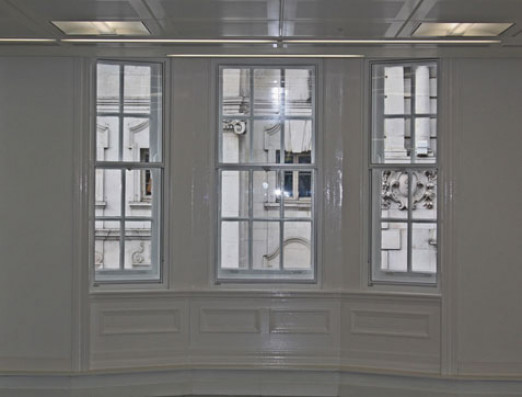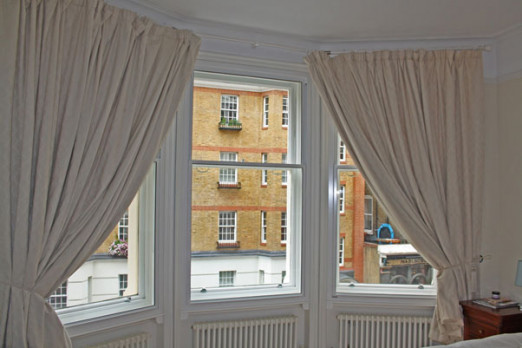A brand-new school and centre of excellence for special educational needs has opened in Chester’s historic Abbey Square, which required Selectaglaze secondary glazing for part of the transformation and conversion of Grade II* Listed Georgian buildings.
Set in the grounds of the imposing 600-year-old Chester Cathedral, are two Georgian buildings which have been carefully and sympathetically renovated to become ‘Abbey School for Exceptional Children’. Grade II* Listed and within the surrounding conservation area, Cheshire West and Chester Planning Authority, and Chester Cathedral's Fabric Design Committee, as well as Historic England, had to be consulted and approve any changes that were to be made to the buildings.
The townhouses were built on land belonging to the Dean and Chapter of the Cathedral, between 1754 and 1760. Some of the most striking external features are the windows; fine examples including 12-pane Georgian box sashes, as well as a couple of tripartite 4-12-4 pane sashes. Most of the windows were original and single glazed, which provided little thermal insulation for the students who would be occupying the spaces and allowed the noise of passing tourists visiting the historic square to enter the rooms.
Barron Design, Cardiff office, was employed to create the blueprint for the conversion due to their pedigree in designing exemplar buildings for people with challenging behaviours. Owing to the Listing, many period features had to be retained and restored, which included an original Chinese Chippendale staircase and the windows, one of which is a beautiful stained-glass composition.
Airflow was one of the key elements of the design, so a sustainable multiroom ventilation and heat recovery system (MVHR) along with an air source heat pump was installed to create a comfortable environment for students and teachers alike. However, without addressing the performance of the original glazing, some of the benefits of these new systems would be negated. Up to 60% of internal heat can be lost through ill-fitting single glazed primary windows and will do little to prevent draughts. As secondary glazing is a fully independent, and tightly sealed internal window system, it will minimise draughts and stop heat loss, creating a more even internal temperature. Secondary glazing is generally accepted by heritage agencies for use in these types of buildings as it is a reversible adaptation. So, Barron Design contacted Fenestral, trusted partner of Selectaglaze, to discuss options, suitable treatments and installation of the units thereafter.
The specification of the secondary glazing included 6.8mm laminate K glass. The choice of glass thickness and type, and installation of the units with a cavity of well over 200mm from the primary glazing will result in a noise reduction in excess of 45dB. Lower U-values were achieved due to the low-E coating and the laminate interlayer provided protection against impact and met safety concerns for the pupils.
A total of 70 units were installed over three floors, in the two buildings, in classrooms, sensory rooms, dining areas and accommodation. The arrangement of the secondary glazing units to meet the original sightlines of the primary glazing, saw seven different systems used, some of which had to be coupled together.
There was a desire to maintain operation of the historic shutters, so this required the secondary glazing to be fitted to the room side of them at the greatest possible cavity. To enable this, a special rebated timber ground was used. At this reveal position there was no window board, so rather than enlarge the existing board it was decided to extend the line of the secondary glazing to the floor. This had the added advantage of encapsulating the wall area below the window, thought to be an additional thermal weakness. Series 46 fixed lights were used below sill level and transom coupled to either Series 60, where there are off set sashes, or Series 20 where the sashes are of equal size. For the exceptionally large windows, over 3m, Series 90’s were specified. With their larger balance capacity these heavy-duty sliders can easily cope with the added glass weight.
All units were fitted with locks to prevent unauthorised operation by pupils; these included fitch catches for the Series 20 and 60, flush locks for the Series 45 and Series 90. U-channels were also included in all the vertical sliding units to not only keep running tracks clean and clear but adding another element of safety for curious pupils.
“The existing windows, although original and striking where not fit for purpose of a modern school setting. We needed a special secondary glazing system that not only protected the existing historic windows but also improved acoustics and the thermal efficiency of the school, without compromising on their functionality and design. Fenestral worked very closely with the design team to ensure the selected products only served to enhance the build. We have been delighted with the service and quality of product provided but more importantly, so are the end-users.” Comments Barron Design
The Abbey School is of exceptional design, catering for exceptional children whose needs are complex and challenging. The sympathetic and creative conversion of these Georgian townhouses has created comfortable and resourceful areas for the staff and pupils alike. It is now a more sustainable environment, creating a sense of well-being and pride for all; set to deliver state of the art education for up to 75 children per year aged between 4 and 19.
Founded in 1966, Royal Warrant Holder Selectaglaze has considerable experience of working within Listed and sensitive buildings. An extensive range of literature and guidance notes covering acoustics, thermal performance and added security is offered together with a technical advisory service and RIBA approved CPD seminars. Sign up on spotlight blogs for monthly Selectaglaze e-bulletins, with recent updates, new blogposts and events





